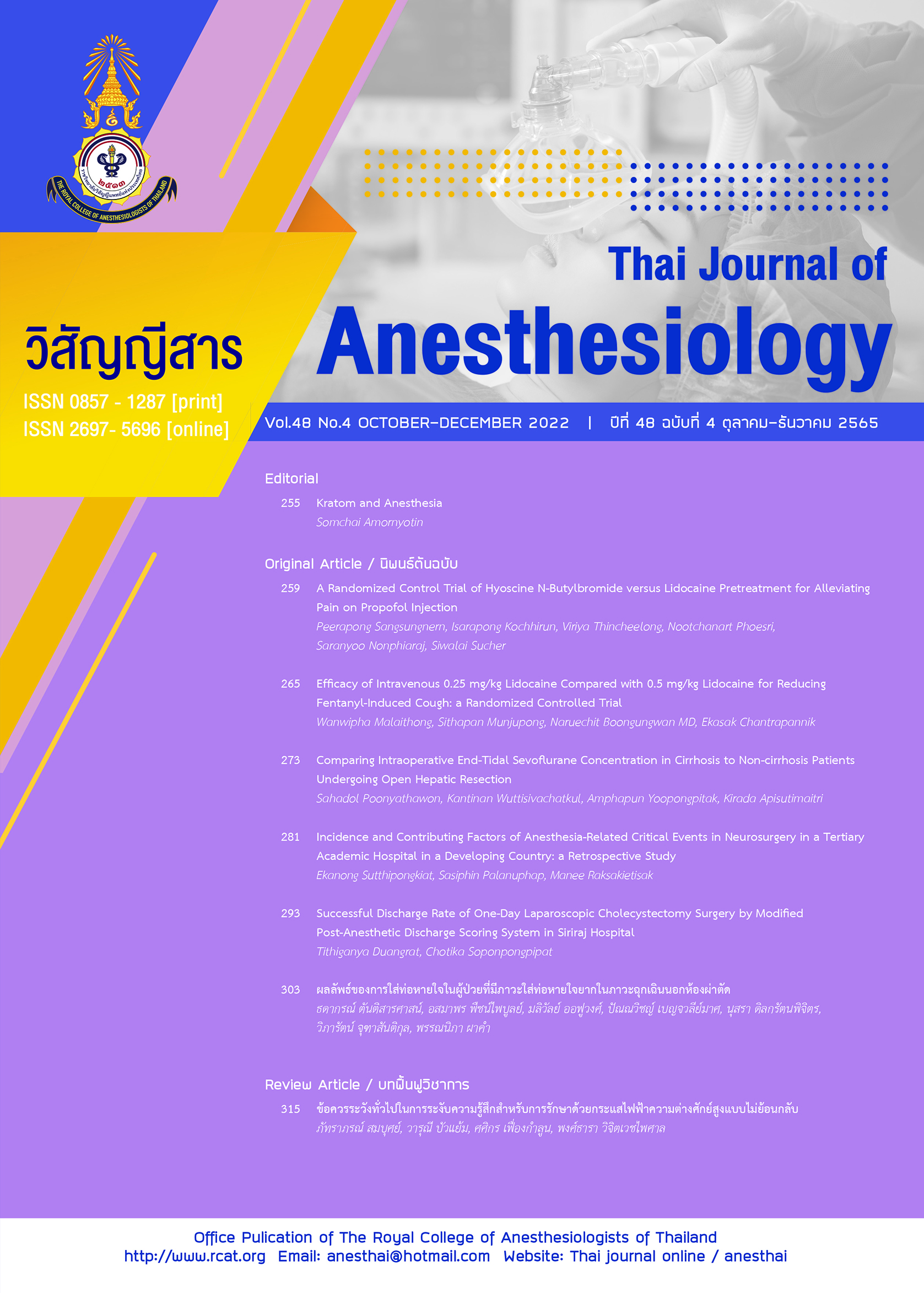General Anesthetic Precaution in Irreversible Electroporation
Main Article Content
Abstract
Irreversible Electroporation or Nanoknife is an innovative insertion of needles through the skin for tumor ablation. Consequently, the high electric field creates nanapores in the cell membrane resulting cell death without triggering an inflammatory process, hence bodily immunological response can eradicate it without a trace. Therefore, a Nanoknife is a safe technique in preservation of vital and scaffolding structures within the treatment zone such as gall bladder, pancreas, ureter, blood vessel or nerve fibers. In addition, it reduces susceptibility to heat sink effects which is implicated as a possible contributing cause of the residual tissue and recurrent tumor. However, this procedure can result in full body muscle spasm, severe muscle contraction and cardiac dysrhythmias. As a result, anesthesia personnel have to be aware of the sequence of events. Typically, they provide general anesthesia with endotracheal intubation and muscle relaxation as well as monitor patients’ vital signs particularly an electrocardiography throughout the process. Additionally, a defibrillator must be readily available in case of emergency cardiac arrythmia and arrest.
Article Details

This work is licensed under a Creative Commons Attribution-NonCommercial-NoDerivatives 4.0 International License.
References
Chen Y, Moser M, Luo Y, Zhang W, Zhang B. Chemical enhancement of irreversible electroporation: a review and future suggestions. Technol Cancer Res Treat. 2019;18:1533033819874128.
Rubinsky B, Onik G, Mikus P. Irreversible electroporation: a new ablation modality-clinical implications. Technol Cancer Res Treat. 2007;6:37-48.
Ansari D, Kristoffersson S, Andersson R, Bergenfeldt M. The role of irreversible electroporation (IRE) for locally advanced pancreatic cancer: a systematic review of safety and efficacy. Scand J Gastroenterol. 2017;52:1165-71.
Aycock K, Davalos R. Irreversible electroporation: background, theory, and review of recent developments in clinical oncology. Bioelectricity. 2019;1:214-34.
Davalos R, Mir L, Rubinsky B. Tissue ablation with irreversible electroporation. Ann Biomed Eng. 2005;33:223-31.
Hsiao C, Huang K. Irreversible electroporation: a novel ultrasound-guided modality for non-thermal tumor ablation. J Med Ultrasound. 2017;25:195-200.
Dollinger M, Beyer L, Haimerl M, et al. Adverse effects of irreversible electroporation of malignant liver tumors under CT fluoroscopic guidance: a single-center experience. Diagn Interv Radiol. 2015;21:471-5.
Lavee J, Onik G, Mikus P, Rubinsky B. A novel nonthermal energy source for surgical epicardial atrial ablation: irreversible electroporation. Heart Surg Forum. 2007;10:E162-7.
Latham NY. AngioDynamics receives FDA approval to initiate NanoKnife® DIRECT Clinical study for the treatment of stage III pancreatic cancer. [cited 2021 Feb 8]. Available from: URL: https://www.angiodynamics.com/announcements/angiodynamics-receives-fda-approval-to-initiate-nanoknife-direct-clinical-study-for-the-treatment-of-stage-iii-pancreatic-cancer-2/
สมราช ธรรมธรวัฒน์. รักษามะเร็งตับและมะเร็งตับอ่อนด้วยมีดนาโน. [cited 2020, Nov 18]. Available from: URL:https://www.si.mahidol.ac.th/th/healthdetail.asp?aid=1292
Jourabchi N, Beroukhim K, Tafti BA, Kee ST, Lee EW. Irreversible electroporation (NanoKnife) in cancer treatment. Gastrointest Interv. 2014;3:8-18.
Reddy VY, Koruth J, Jais P, et al. Ablation of atrial fibrillation with pulsed electric fields-an ultra-rapid,
tissue-selective modality for cardiac ablation. J Am Coll Cardiol EP. 2018;4:987-95.
Lafranceschina S, Brunetti O, Delvecchio A, et al. Systematic review of irreversible electroporation role in management of locally advanced pancreatic cancer. Cancers. 2019;11:1718.
Deipolyi AR, Golberg A, Yarmush ML, Arellano RS, Oklu R. Irreversible electroporation: the evolution of a laboratory technique to be used in interventional oncology. Diagn Interv Radiol. 2014;20:147-54.
Guenther E, Klein N, Zapf S, et al. Prostate cancer treatment with irreversible electroporation (IRE): safety, efficacy and clinical experience in 471 treatments. PLOS ONE. 2019;14:e0215093.
Malik NK, May KS, Chandrasekhar R, et al. Treatment of locally advanced unresectable pancreatic cancer: a 10-year experience. J Gastrointest Oncol. 2012;3:326-34.
Vroomen LGPH, Petre EN, Cornelis FH, Solomon SB, Srimathveeravalli G. Irreversible electroporation and thermal ablation of tumors in the liver, lung, kidney and bone: what are the differences? Diagn Interv Imaging. 2017;98:609-17.
Narayanan G, Hosein PJ, Beulaygue IC, et al. Percutaneous image-guided irreversible electro-poration for the treatment of unresectable, locally advanced pancreatic adenocarcinoma. J Vasc Interv Radiol. 2017;28:342-8.
Narayanan G, Froud T, Suthar R, Barbery K. Irreversible electroporation of hepatic malignancy. Semin Intervent Radiol. 2013;30:67-73.
Kiełbik A, Szlasa W, Saczko J, Kulbacka J. Electroporation-based treatments in urology. Cancers. 2020;12:2208.
Silk M, Tahour D, Srimathveeravalli G, Solomon S, Thornton R. The state of irreversible electroporation in interventional oncology. Semin Intervent Radiol. 2014;31:111-7.
Sugimoto K, Kakimi K, Takeuchi H, et al. Irreversible electroporation versus radiofrequency ablation: comparison of systemic immune responses in patients with hepatocellular carcinoma. J Vasc Interv Radiol. 2019;30:845-53.e6.
Tamura M, Pedersoli F, Schulze-Hagen M, et al. Predictors of occlusion of hepatic blood vessels after irreversible electroporation of liver tumors. J Vasc Interv Radiol. 2020;31:2033-42.e1.
Zhao J, Wen X, Tian L, et al. Irreversible electroporation reverses resistance to immune checkpoint blockade in pancreatic cancer. Nat Commun. 2019;10:899.
Sombood P, Noipitak S, Vichitvejpaisal P. Non-operating room anesthesia: the same principles but differences in context. Siriraj Med Bull. 2021;14:19-27.
เบญจรัตน์ หยกอุบล. งานบริการนอกห้องผ่าตัด. ใน: อังกาบ ปราการรัตน์, วิมลลักษณ์ สนั่นศิลป์, ศิริลักษณ์ สุขสมปอง, ปฏิภาณ ตุ่มทอง. ตำราวิสัญญีวิทยา. พิมพ์ครั้งที่ 4. กรุงเทพฯ. เอ-พลัส พริ้น; 2556;701-25.
Wong T, Georgiadis PL, Urman RD, Tsai MH. Non-operating room anesthesia: patient selection and special considerations. Local Reg Anesth. 2020;13:1-9.
Martin RC, Schwartz E, Adams J, Farah I, Derhake BM. Intra-operative anesthesia management in patients undergoing surgical irreversible electroporation of the pancreas, liver, kidney, and retro-peritoneal tumors. Anesth Pain Med. 2015;5:e22786.
Amornyotin S. Monitoring equipment for gastrointestinal endoscopy. Thai J Anesthesiol. 2018;44:143-8.
White PF, Song D. New criteria for fast-tracking after out-patient anesthesia: a comparison with modified Aldrete’s scoring system. Anesth Analg. 1999;88:1069-72.
Whitaker DK, Booth H, Clyburn P. et al. Immediate post-anaesthesia recovery 2013: Association of Anaesthetists of Great Britain and Ireland. Anaesthesia. 2013;68:288-97.


